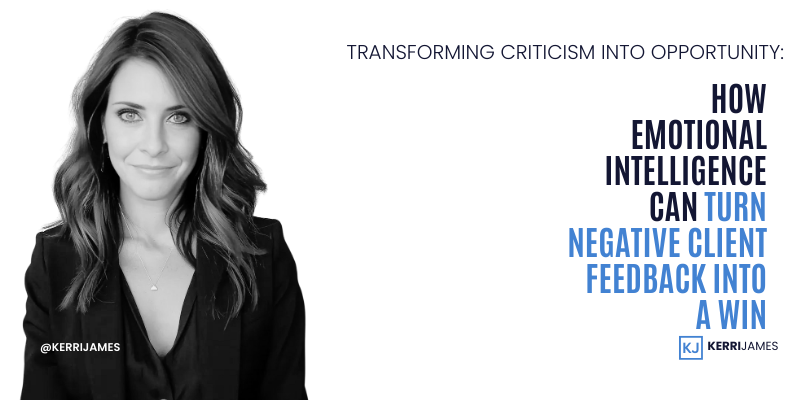Negative client feedback isn’t something anyone enjoys receiving. It can sting, trigger defensiveness, and even feel like a personal attack. But what if, instead of viewing negative feedback as a failure, we saw it as a valuable opportunity? An opportunity to learn, grow, and strengthen our client relationships? I remember when I first received a harsh client complaint. It stung, but it also ignited a fire in me to improve. This isn’t about simply accepting criticism; it’s about using emotional intelligence to transform negative client feedback into a powerful tool for positive change. This post explores how we can leverage emotional intelligence to navigate difficult client conversations, address concerns effectively, and ultimately, turn negative feedback into a win for both our clients and our practices.
The Power of Emotional Intelligence in Legal Practice:
Emotional intelligence (EQ) refers to the ability to understand and manage both our own emotions and the emotions of others. It encompasses a range of abilities such as self-awareness, self-regulation, motivation, empathy, and social skills. These skills are critical in every profession that requires frequent human interaction, but they are especially vital in fields such as law, where emotions are often heightened, and the stakes are high. For lawyers, emotional intelligence is more than just a “nice-to-have” quality; it is a fundamental competency that can directly influence the quality of client relationships, the effectiveness of communication, and the overall success of legal practice.
The Importance of High EQ in Law:
Lawyers often find themselves at the intersection of logic, strategy, and intense human emotion. Clients come to attorneys during some of the most challenging moments in their lives—facing divorce, financial ruin, criminal charges, or other significant legal issues. In such circumstances, emotions like fear, anger, frustration, and sadness are common, and these emotions can cloud judgment or lead to impulsive decisions. Without emotional intelligence, lawyers may struggle to navigate these turbulent waters, making it difficult to connect with clients and serve their best interests effectively.
Emotional intelligence allows lawyers to remain calm and composed, even when faced with criticism or negative client feedback. It helps them manage their own emotional responses, enabling them to engage with clients with a clear mind and empathy. A lawyer with high EQ can take the heat in difficult situations, maintain a professional demeanor, and work constructively to address the client’s concerns. Moreover, high EQ fosters stronger relationships with clients, as it enables attorneys to empathize with their clients’ emotions and respond in a way that promotes trust and cooperation.
A key aspect of emotional intelligence that my mentors, Ken Hardison, Chris Mullins, and Harlan Schillinger, instilled in me is the idea of viewing every interaction, including those involving negative feedback, as an opportunity for growth. This mindset shift is central to leveraging emotional intelligence. Instead of becoming defensive or dismissive when faced with criticism, emotional intelligence encourages lawyers to view the feedback as an opportunity to learn, improve, and strengthen the relationship with the client. By approaching feedback with empathy and an open mind, lawyers can transform potentially negative experiences into moments of connection and trust-building.
Understanding the Client’s Perspective:
One of the foundational skills within emotional intelligence is empathy—the ability to understand and share the feelings of others. When working with clients, empathy is crucial, particularly when they are dissatisfied with the progress of their case or frustrated with the legal process. Before responding to negative client feedback, a lawyer must first make the effort to deeply understand the client’s perspective. What are the root causes of their dissatisfaction? What unmet needs and expectations are driving their emotions?
Active listening is a key tool in this process. Lawyers should not only listen to what clients are saying, but also pay close attention to how they are saying it. A client’s tone of voice, body language, and emotional expressions can provide valuable insights into their underlying concerns. Are they anxious because they feel like they haven’t been kept informed? Are they angry because they feel unheard or neglected? These emotional cues are important signals that can guide a lawyer’s response.
A phrase like “I can understand why you’d feel that way” can go a long way toward diffusing tension and showing clients that their emotions are valid. This simple phrase demonstrates empathy and acknowledges the validity of the client’s experience. Even if a lawyer does not agree with every aspect of the client’s feedback whether its negative client feedback or complaint, this expression of understanding opens the door for more productive communication. It helps clients feel heard, respected, and supported, which are essential components of a strong attorney-client relationship.
To understand a client’s perspective fully, lawyers must actively engage with them in a way that demonstrates genuine interest in their feelings and needs. This might mean asking open-ended questions, giving clients space to express their emotions, or using reflective statements to clarify what has been said. Lawyers who can engage with clients empathetically can navigate difficult situations with ease and foster a stronger sense of connection, which in turn can lead to better legal outcomes.
Responding with Empathy and Understanding:
Once a lawyer has taken the time to understand the client’s perspective, the next step is to respond in a manner that is calm, professional, and empathetic. This can be challenging, particularly when the criticism or negative feedback feels unjust or unfounded. However, reacting defensively or dismissively can severely damage the relationship and undermine the client’s trust.
Instead, emotional intelligence encourages lawyers to remain composed and acknowledge the client’s concerns, even if they believe the criticism is unfair. The goal of the response is not to assign blame or justify actions, but to focus on repairing the relationship and restoring trust. A lawyer’s ability to express empathy and understanding during these moments can help defuse tension and steer the conversation in a more constructive direction.
For instance, if a client feels frustrated because they believe their case has not progressed as expected, the lawyer might begin by saying something like, “I understand that you are feeling frustrated right now, and I can see why you’d feel that way given the circumstances.” This kind of empathetic acknowledgment helps the client feel validated and understood. Next, the lawyer should explain the situation clearly, without being defensive. For example, “I want to make sure we are on the same page regarding the steps in your case and what to expect moving forward.”
At times, responding with empathy may even involve apologizing for any shortcomings in service or communication, even if the lawyer believes they were not entirely at fault. Apologizing can be a powerful tool in re-establishing trust, as it demonstrates accountability and a commitment to the client’s best interests. A lawyer might say, “I apologize if I haven’t communicated as clearly as I should have. Let’s work together to ensure we are aligned moving forward.” This kind of statement demonstrates empathy while also creating an opportunity for collaboration.
In instances where a client’s expectations were not realistic, emotional intelligence can help guide the conversation in a way that gently manages those expectations. Rather than dismissing the client’s viewpoint or becoming confrontational, the lawyer can express understanding and then provide clarity. “I know you were hoping for a quicker resolution, and I understand how frustrating this process can be. Let’s talk about the next steps and how we can work toward the best possible outcome, given the circumstances.”
It’s important to remember that the goal is not to defend one’s actions or to place blame but to open the lines of communication and focus on moving forward. By responding to negative feedback with empathy, the lawyer demonstrates a commitment to the client’s needs and a willingness to resolve any issues collaboratively.
View Every Challenge as an Opportunity:
Viewing every challenge as an opportunity is a key mindset shift that can transform how lawyers approach difficult situations. Rather than seeing negative feedback as something to avoid or resent, emotional intelligence teaches lawyers to embrace these moments as chances to grow, learn, and improve. This shift in mindset can significantly impact the quality of the lawyer-client relationship and the overall success of the legal practice.
When a lawyer adopts this perspective, they become more resilient in the face of criticism. Instead of reacting defensively, they view each challenge as an opportunity to improve their services, communication, and approach. They also gain valuable insights into their own behavior and performance, allowing them to refine their practice and better meet the needs of future clients.
For instance, if a client expresses dissatisfaction with the lawyer’s communication style, rather than taking it personally, the lawyer can use the feedback to evaluate their communication strategies and make improvements. Perhaps the lawyer needs to be more proactive in providing updates or take more time to explain complex legal concepts. By viewing this feedback as a constructive tool, the lawyer enhances their ability to serve clients more effectively.
The ability to view every challenge as an opportunity can also foster a growth-oriented culture within a law firm. When lawyers approach negative feedback with emotional intelligence, they set a positive example for colleagues and staff. This mindset encourages continuous learning and improvement, which ultimately benefits clients and the firm as a whole.
Investing in Client-Centric Approaches:
Emotional intelligence is not only about managing emotions in difficult situations; it’s also about cultivating a client-centric approach that prioritizes the emotional and practical needs of the client. Lawyers who leverage emotional intelligence are better able to understand what clients need beyond just the legal resolution. They can connect with clients on a deeper level, which helps to establish a strong foundation of trust and mutual respect.
By practicing empathy and emotional intelligence, lawyers can improve their ability to identify the emotional drivers behind a client’s actions and decisions. For example, a client who insists on pursuing a particular legal strategy might be doing so out of a need for control or fear of loss. Recognizing these emotional motivations allows the lawyer to adjust their approach, whether that means addressing the client’s concerns more effectively or helping them explore alternative strategies that might better meet their needs.
Additionally, when lawyers demonstrate emotional intelligence, they create a more positive and collaborative environment, where clients feel safe and valued. This approach fosters open communication, encourages client feedback, and ultimately leads to better outcomes, both in terms of legal results and client satisfaction.
In conclusion, emotional intelligence is an essential tool for lawyers seeking to build strong, effective relationships with their clients. By understanding and managing their own emotions, as well as empathizing with the emotions of clients, lawyers can respond constructively to criticism, improve communication, and enhance client satisfaction. In the end, emotional intelligence is not only about managing difficult situations; it’s about creating an environment in which clients feel heard, respected, and valued, ultimately leading to more successful and fulfilling legal practice.
Turning Feedback into Actionable Steps
Feedback, especially negative feedback, is often seen as a challenge. In many professions, particularly in law, receiving criticism or complaints from clients can feel uncomfortable or even discouraging. However, when viewed through a lens of opportunity, negative feedback can be an invaluable tool for improvement and growth. Clients who are willing to express dissatisfaction are giving valuable insight into areas where service can be improved, and if handled properly, that feedback can be transformed into actionable steps that enhance the overall client experience.
The first step in turning feedback into actionable steps is to understand the core of the client’s concerns. Negative feedback is often a reflection of unmet expectations, miscommunications, or frustrations that arise from how a client perceives the service being provided. It is crucial for attorneys and their teams to actively listen to the client, identifying both the emotional and practical components of the feedback. For example, a client might express dissatisfaction with the speed of communication or the lack of clarity in the explanations they’ve received regarding their case. Recognizing these concerns as opportunities for improvement, rather than dismissing them, is the first step in transforming feedback into concrete actions.
Once the concerns are fully understood, the next step is to take concrete steps to address them. Depending on the nature of the feedback, these steps might involve several strategies. For instance, if clients express dissatisfaction with slow communication, a law firm might consider implementing a more robust system for keeping clients updated. This could include setting up automated status updates, assigning specific team members to check in regularly with clients, or introducing weekly or bi-weekly calls to ensure that clients are informed about the progress of their case.
Another approach could involve internal process changes. Perhaps feedback reveals that clients are confused by the way information is being shared with them, indicating that staff may need additional training in client communication. Investing in the right systems and people is crucial here. Training team members to communicate more effectively, both with clients and internally, can lead to a significant improvement in client satisfaction. It also helps in preventing issues from arising again in the future. Clear and concise communication is an essential skill for any legal team, and ensuring that staff have the tools they need to succeed will not only enhance client satisfaction but also streamline operations and reduce errors.
In some cases, feedback might highlight the need for changes in service delivery. For example, clients may express frustration with the lack of flexibility in scheduling or difficulty in accessing legal resources. Responding to such feedback might involve introducing more flexible scheduling systems or offering digital tools for clients to access documents and track their case progress online. These steps may seem simple, but they show clients that their feedback is not only being heard but also acted upon.
Importantly, when making changes based on client feedback, it’s essential to maintain transparency. Clients should be kept informed about the actions being taken and the progress being made. A lawyer’s commitment to improving the service should be evident not only through the changes themselves but also through clear communication about what is being done to address their concerns. This transparency fosters a sense of trust and partnership, demonstrating that the lawyer truly cares about the client’s experience and is dedicated to providing the best service possible.
The Retention Advantage
One of the most significant benefits of turning negative client feedback into actionable steps is the impact it can have on client retention. Legal services, like any other service, rely on strong relationships and trust between the provider and the client. Clients who feel heard, valued, and confident that their concerns are being addressed are far more likely to remain loyal to the firm, even in the face of challenges.
When a client has a complaint, it is an opportunity to show them that their relationship with you is not just transactional but that you are a long-term partner in their success. Clients who feel that a law firm is committed to addressing their concerns, and who witness firsthand the firm’s willingness to improve, are more likely to develop a deeper sense of loyalty. This kind of emotional connection is essential in maintaining long-term client relationships. In fact, clients who feel personally supported and valued are more likely to refer the firm to others. This creates a cycle of positive word-of-mouth referrals, which can significantly grow a law practice’s client base over time.
I remember when I first started incorporating the principles of feedback and emotional intelligence into my practice, I began to see a remarkable shift in client retention. Clients who had previously been on the fence about continuing their relationships with my firm became more engaged, knowing that their concerns were being taken seriously and addressed with care. I realized that this wasn’t just about fixing individual problems—it was about creating a culture of improvement, trust, and empathy. The benefits of this approach were not just seen in client satisfaction, but also in the lasting impact it had on my business growth. Client retention skyrocketed, and it became clear that addressing negative client feedback proactively could be a game changer for the firm.
Furthermore, happy and loyal clients are often more forgiving if mistakes are made. They are more likely to focus on the steps being taken to resolve the issue rather than the issue itself. In many cases, a client who has had their feedback addressed in a thoughtful and effective manner may feel more satisfied than a client who has never experienced any problems at all. The experience of having their concerns taken seriously and seeing their feedback lead to change strengthens the relationship, increasing both client loyalty and satisfaction.
Practical Tips for Handling Negative Feedback
- Listen Actively:
Active listening is the cornerstone of effective feedback management. When clients voice concerns, it’s essential to give them your full attention. This means eliminating distractions and focusing on understanding not only what they are saying but how they are saying it. Pay attention to their tone, body language, and emotional expressions. These signals offer important clues to the underlying emotions driving their concerns. Ask clarifying questions if necessary to ensure you fully understand their perspective. Simple phrases like, “I hear that this situation has been frustrating for you. Can you tell me more about what’s been happening?” can encourage clients to share more details, which can be invaluable in finding a resolution.
- Empathize:
Acknowledging and validating the client’s feelings is a crucial step in building rapport and trust. Even if you don’t fully agree with their perspective, you can still empathize with the emotions behind it. Expressing understanding can significantly de-escalate tense situations and demonstrate that you care about the client’s experience. A phrase like, “I can see why you would feel that way, and I understand why it’s important to you,” helps the client feel heard and valued. This is particularly crucial when the feedback relates to emotional or subjective concerns, as it reassures clients that their feelings are important to you.
- Take Responsibility:
Taking responsibility for any shortcomings in service or communication is another key aspect of handling negative feedback. Even if the issue wasn’t directly your fault, acknowledging the client’s frustration and apologizing for any inconvenience they have experienced can go a long way in repairing the relationship. The apology should focus on the client’s experience, not on assigning blame. A statement like, “I’m sorry that this situation has caused you frustration,” can help shift the conversation from blame to resolution, allowing you to focus on addressing the client’s needs.
- Offer Solutions:
Once the client feedback has been heard and validated, it’s time to offer concrete steps to address the concerns raised. This might involve changes to internal processes, improvements in communication, or new strategies for managing client expectations. Be clear about what changes will be made, and be specific about timelines. For example, if a client is dissatisfied with the speed of communication, you might say, “To ensure that you are kept up to date more regularly, we will implement weekly check-ins to update you on the progress of your case.”
- Follow Up:
After implementing the necessary changes, it’s crucial to follow up with the client to ensure their concerns have been addressed to their satisfaction. This follow-up reinforces your commitment to the client’s experience and allows you to make any further adjustments if needed. A simple message or phone call, such as, “I just wanted to check in and make sure that the recent changes we made have addressed your concerns,” shows clients that their feedback matters and that you are genuinely committed to providing them with the best possible service.
Example Scenario:
A client expresses frustration with the lack of communication regarding their case. They feel left in the dark and uncertain about the progress being made. Instead of becoming defensive, the lawyer acknowledges the client’s frustration and apologizes for the lack of communication. They then explain the steps they will take to improve communication, such as providing regular updates via email or phone calls. The lawyer also sets up a system for tracking communication to ensure the client stays informed. This proactive approach not only addresses the client’s immediate concerns but also demonstrates a commitment to improving service, which strengthens the client relationship.
Final words: Turning Negative client feedback into Growth Opportunities
Negative client feedback isn’t a sign of failure; it’s an opportunity for growth. By leveraging emotional intelligence, we can transform criticism into valuable insights, improve our services, and build stronger client relationships. It’s about shifting our mindset from defensiveness to receptiveness, viewing negative feedback not as a threat but as a chance to learn and excel.










